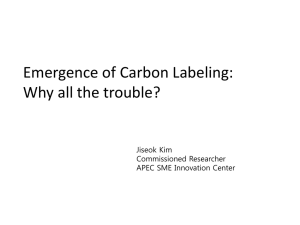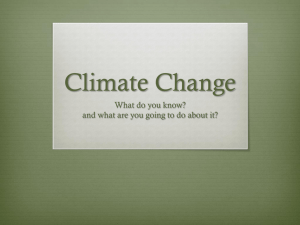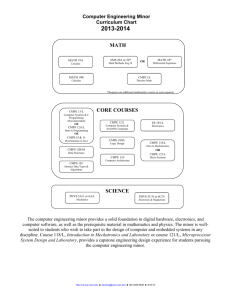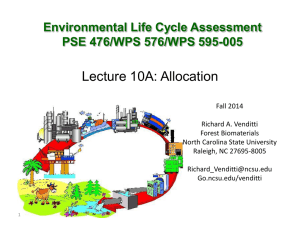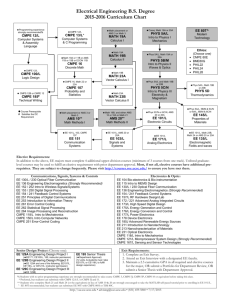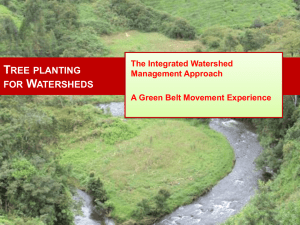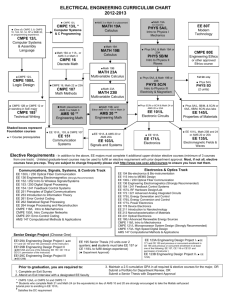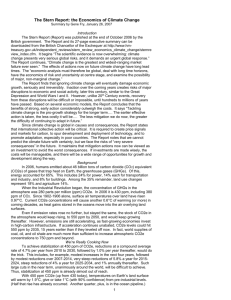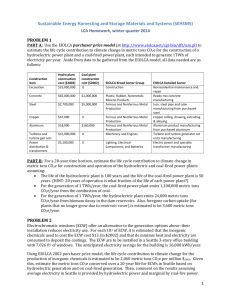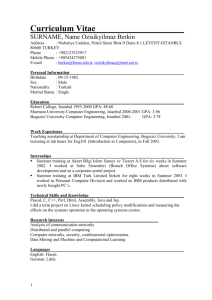Project Idea Note or PIN
advertisement
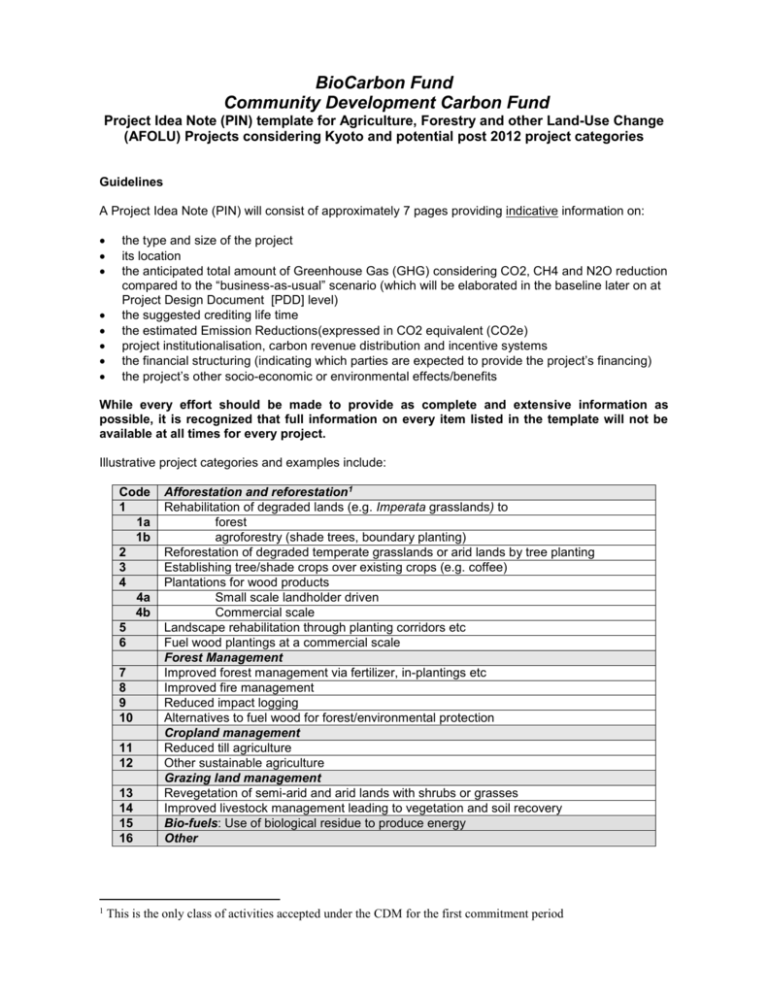
BioCarbon Fund Community Development Carbon Fund Project Idea Note (PIN) template for Agriculture, Forestry and other Land-Use Change (AFOLU) Projects considering Kyoto and potential post 2012 project categories Guidelines A Project Idea Note (PIN) will consist of approximately 7 pages providing indicative information on: the type and size of the project its location the anticipated total amount of Greenhouse Gas (GHG) considering CO2, CH4 and N2O reduction compared to the “business-as-usual” scenario (which will be elaborated in the baseline later on at Project Design Document [PDD] level) the suggested crediting life time the estimated Emission Reductions(expressed in CO2 equivalent (CO2e) project institutionalisation, carbon revenue distribution and incentive systems the financial structuring (indicating which parties are expected to provide the project’s financing) the project’s other socio-economic or environmental effects/benefits While every effort should be made to provide as complete and extensive information as possible, it is recognized that full information on every item listed in the template will not be available at all times for every project. Illustrative project categories and examples include: Code 1 1a 1b 2 3 4 4a 4b 5 6 7 8 9 10 11 12 13 14 15 16 1 Afforestation and reforestation1 Rehabilitation of degraded lands (e.g. Imperata grasslands) to forest agroforestry (shade trees, boundary planting) Reforestation of degraded temperate grasslands or arid lands by tree planting Establishing tree/shade crops over existing crops (e.g. coffee) Plantations for wood products Small scale landholder driven Commercial scale Landscape rehabilitation through planting corridors etc Fuel wood plantings at a commercial scale Forest Management Improved forest management via fertilizer, in-plantings etc Improved fire management Reduced impact logging Alternatives to fuel wood for forest/environmental protection Cropland management Reduced till agriculture Other sustainable agriculture Grazing land management Revegetation of semi-arid and arid lands with shrubs or grasses Improved livestock management leading to vegetation and soil recovery Bio-fuels: Use of biological residue to produce energy Other This is the only class of activities accepted under the CDM for the first commitment period Name of Project PROJECT IDEA NOTE Name of Project: Date submitted: A. Project description, type, location and schedule General description A.1 Project description and proposed activities Provide information on the i) objectives of the project, ii) size of the project in ha and if the project is sub-divided in smaller areas, iii) innovations involved and iv) economic drivers of the project apart from carbon finance opportunities A.2 Project category adopted and description of introduced technologies Select code(s) of project category(ies) from the list above and describe the current and alternative land use practices with reference to existing pilot activities Project proponent submitting the PIN A.3 Name A.4 Organizational category (choose one or more) a. b. c. d. e. Government Government agency Municipality Private company Non Governmental Organization A.5 Other function(s) of the project developer in the project (choose one or more) a. b. c. d. Sponsor Operational Entity under the CDM Intermediary Technical advisor A.6 Summary of relevant experience A.7 Address A.8 Contact person A.9 Telephone / fax A.10 E-mail and web address Project sponsor(s) financing the project (List and provide the following information for all project sponsors) 1 Name of Project A.11 Name A.12 Organizational category (choose one or more) f. g. h. i. j. Government Government agency Municipality Private company Non Governmental Organization A.13 Address (include web address) A.14 Main activities A.15 Summary of the financials (total assets, revenues, profit, etc.) Type of project A.16 Greenhouse gases targeted Please mention gases that will be monitored CO2 / CH4 / N2O Location of the project A.17 Country A.18 Nearest city A.19 Precise location Please provide GPS coordinates from project boundary and subproject area boundaries Expected schedule A.20 Estimate of time required before becoming operational after approval of the PIN Time required for financial commitments: xx months Time required for legal matters: xx months Time required for negotiations: xx months Time required for establishment: xx months A.21 Earliest project start date (Year in which the project will be operational) A.22 Current status or phase of the project a. b. c. d. e. f. Identification and pre-selection phase Opportunity study finished Pre-feasibility study finished Feasibility study finished Negotiations phase Contracting phase A.23 Current status of the acceptance of the project by the Host Country (choose one) a. Letter of No Objection is available b. Letter of Endorsement is under discussion or available c. Letter of Approval is under discussion or available 2 Name of Project B. Expected environmental and social benefits Environmental benefits B.1 Estimate of carbon Up to and including 2012: xx t CO2e sequestered or conserved Up to and including 2017: xx t CO2e (in metric tones of CO2 equivalent – t CO2e). Please attach spreadsheet if available. If information is not available please provide information on: i) site conditions, annual rainfall, altitude, soil type ii) tree species planted per ha, iii) tree harvesting intervals iv) above ground biomass (e.g. trees and mulch) and below ground biomass accumulation (roots and composted organic material) in tones dry matter/ha. B.2 Baseline scenario (What would the future look like without the proposed project? What would the estimated total carbon sequestration / conservation be without the proposed project? Explain why the project is additional, i.e. without the carbon finance project component the project would not take place. B.3 Existing vegetation and land use (What is the current land cover and land use? Is the tree cover more or less than 30%?) B.4 Environmental benefits B.4.a Local benefits B.4.b Global benefits B.5 Consistency between the project and the environmental priorities of the Host Country Socio-economic benefits B.6 How will the project improve the welfare of the community involved in it or surrounding it? What are the direct effects which can be attributed to the project and which would not have occurred in a comparable situation without that project? (e.g., employment creation, 3 Name of Project poverty alleviation, foreign exchange savings). Indicate the number of communities and the number of people that will benefit from this project. B.7 Are there other effects? (e.g., training/education due to the introduction of new technologies and products, replication in the country or the region) C. Finance Project costs C.1 Preparation costs US$ million (e.g. baseline survey, development and documentation costs of carbon finance component) C.2 Establishment costs US$ million (e.g. extension costs to introduce new management practices, tree planting, mulching etc costs) C.3 Other costs (explain) US$ million (e.g. organic or ISO certification) C.4 Total project costs US$ million Sources of finance to be sought or already identified C.5 Equity (Name of the organizations and US$ million) C.6 Debt – Long-term (Name of the organizations and US$ million) C.7 Debt – Short term (Name of the organizations and US$ million) C.8 Grants C.9 Not identified (US$ million) Projects with a big financing gap will not be considered by the Carbon Fund C.11 Sources of carbon finance (Has this project been submitted to other carbon buyers? If so, say which ones) C.12 Indicative price for the emission reductions in US$ per t/CO2e for the first 10 years of the project Subject to negotiation and financial due diligence C.13 Emission Reductions Value offered to the BioCarbon Fund (= price per t CO2e * number of tCO2e) Leave this field empty if you have 4 Name of Project not calculated the estimated emission reductions in section B1 Until 2012 US$ Until 2017 US$ C.14 Financial analysis Please provide the expected financial internal rate of return (FIRR) for the project with and without the carbon finance component (Please attach financial spreadsheet if available.). If you can not estimate the impact of the carbon finance component on the FIRR please list, rank and qualify important decision making parameter for your enterprise to develop a carbon finance project e.g. carbon component should be at least cost covering, partly covering the introduction costs of new activities or within the corporate social responsibility budget ceiling (Please attach financial spreadsheet if available.) FIRR without carbon component: FIRR with carbon component: D. Institutionalization and carbon revenue distribution Institutionalization D.1 In-house capacity to develop, implement and monitor project activities. Please provide information on: i) extension system, number of extension workers and project area covered by extension workers, ii) number of mapping, inventory and monitoring specialists D.2 Internal Control System (ICS) Please describe your ICS system and mention which national and international quality standards are achieved or will be achieved in the future (ISO, organic certification etc) D.3 Project participants, institutional structures and partnerships Please list project participants, describe existing or envisaged institutional structures and partnerships to develop, implement and monitor carbon 5 Name of Project finance project component. Please indicate sustainable financing mechanisms in place covering respective costs. Carbon revenue distribution and incentive systems D.3 Carbon revenue distribution Please explain what you intend to do with the carbon revenues and in particular how small-scale farmers will benefit from the carbon revenues D.4 Incentive systems Please list existing and future incentives of the project that will ensure a high adoption rate of new management practices. Please also indicate the expected level of adoption in % 6
